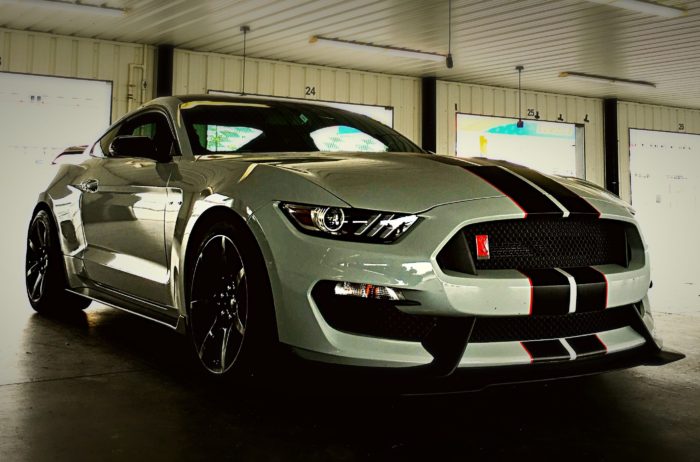Buying the Shelby GT350 and never taking it to the track is like hiring a professional chef to help you operate the microwave, it’s a total waste. You can say the same about most track dedicated cars, but the hardware and engineering of the Shelby GT350 is something you truly need to experience within the confines of a race track. Experiencing the stopping power of the ridiculous brakes on the street may just get you rear-ended, and reaching 8,250 revolutions at the crankshaft on public roads may land you a parking spot in jail. During one mid-May morning I got the magnificent opportunity to flex the GT350’s muscles in its natural habitat (and no, it was not a pedestrian filled sidewalk.)
First and foremost, this is not a Mustang GT. Ford engineers approached the Shelby GT350 design with the intent on building a car with a specific engine: one that revs more freely, has a broad torque curve, and be as light as possible. What they ended up with is a bored out Coyote engine called the Voodoo engine, making 526 horsepower and 429 lb-ft of torque.
At its core lies a Flat Plane Crank, a term representing a crankshaft design with pins configured 180 degrees apart from each other. Looking down the main bearing journals the pins stack behind each other resembling a single flat plane. Traditionally, a muscle car’s V8 crankshaft is cross plane, where the pins are arranged in a cross-like fashion. All that matters behind this technical gibberish is that the Voodoo’s components have less inertia, can spin up to a rate of 8,250 RPM and produces at least 100 horsepower per liter, which is an insane number considering this is a large displacement, naturally aspirated V8 engine. This bonkers engine speed and raw power was validated during my trip to the North American Track Tour at Pocono Raceway, an event put together by Ford Performance to market and teach consumers and members of the media the ins and outs of the new Shelby. I got an opportunity to drive the GT350 around the East Course of the “Tricky Triangle” Raceway with the help of a professional driver sitting shotgun.
This bonkers engine speed and raw power was validated during my trip to the North American Track Tour at Pocono Raceway, an event put together by Ford Performance to market and teach consumers and members of the media the ins and outs of the new Shelby. I got an opportunity to drive the GT350 around the East Course of the “Tricky Triangle” Raceway with the help of a professional driver sitting shotgun.
Gently starting out of the pit lane, the GT350 felt like a quality built racecar that’s been made street legal. The interior is unmistakably Mustang with its dual-cowl dashboard and blacked out trim. On the inside only a few things give the GT350 and the GT350R away: the Shelby Cobra badges and placard, the red-ringed shifter knob, and an exhaust mode toggle switch that turns the exhaust note from Mr. Hyde to Mr. Hyde Plus. Navigating through the esses and short straights, the GT350 possessed plenty of grip out of the staggered setup of 295/35 fronts and 305/35 rears. The relatively flat torque curve and engine breathing room also gave me a lot of flexibility as there is seemingly no wrong gear to choose from.
Navigating through the esses and short straights, the GT350 possessed plenty of grip out of the staggered setup of 295/35 fronts and 305/35 rears. The relatively flat torque curve and engine breathing room also gave me a lot of flexibility as there is seemingly no wrong gear to choose from.
As I mashed the throttle in third gear at the exit point before the long straight, my eyes focused on the tachometer and my ears tuned to the Voodoo’s howl. Approaching 6,000 RPMs my brain commanded every cell in my body to depress the clutch and upshift into fourth. And upshifted I did. Quickly my driving instructor, Gunnar Jeannette, a professional racing driver who at 18 years old became the youngest person to have ever finished the 24 Hours of Le Mans, disappointingly shouted “that was too early! Take it over 8,000!” I had robbed the engine’s power and wasted critical acceleration potential.
All I can think of was the Fast and Furious’ Johnny Tran saying, “Too soon junior!” exposing my less than amateurish driving abilities to this world renowned racing driver. I then sheepishly heel-and-toed back into third, leaving behind an unnecessarily large braking zone behind me. Salvaging the lap, I tried to make up for my mistake by pushing the Shelby further into the corners and standing on the brake pedal at some points. The gigantic brakes of the GT350, which consists of an interesting construction of aluminum hat and cross-drilled iron rotors, meant I can be hard on the brakes and could go on and on without being punished by the uncertainty of brake fade. Besides the limitless engine, the brakes are one of the best features of the Shelby GT350. The 6 piston radially mounted Brembo caliper up front and 4 caliper in the rear allowed me to brake a bit later, bite harder, and was forgiving enough in case I went into a corner a little too hot.
Salvaging the lap, I tried to make up for my mistake by pushing the Shelby further into the corners and standing on the brake pedal at some points. The gigantic brakes of the GT350, which consists of an interesting construction of aluminum hat and cross-drilled iron rotors, meant I can be hard on the brakes and could go on and on without being punished by the uncertainty of brake fade. Besides the limitless engine, the brakes are one of the best features of the Shelby GT350. The 6 piston radially mounted Brembo caliper up front and 4 caliper in the rear allowed me to brake a bit later, bite harder, and was forgiving enough in case I went into a corner a little too hot.
I managed to guide myself through the chicanes and short right and left hander turns fairly well. The GT350 felt completely neutral through these autocross like turns, never misbehaving and stayed completely poised and confident at my limits. Perhaps it was the Magneride dampers keeping the car normal and loading the four tires appropriately, or perhaps I was not pushing the car hard enough. All I thought about was setting myself up properly for the long straight to wail on the throttle again. The second time around entering the long straight, I planted my right foot down and watched the needle climb over thousands of RPMs. The voices in my head reminded me to keep it planted and not shift too early, but my primitive brain, programmed through years of slower spinning crankshafts, wanted to resist. So I kept the pedal to the floor and the flat torque curve kept pinning my body against the racing style seats. The acceleration was reminiscent of the Tesla Model S where it just kept pushing and pushing. I climbed over the 6,000 RPM mark. My eyes darted left and right as if I’ve been caught doing something sinfully wrong. 7,000 RPMs. “KEEP GOING!” Gunnar exclaimed. I waited for loud bangs, bent valves, and gouged pistons. Disregarding logic, I crossed over 8,000 RPMs. “SHIFT UP!” I quickly depressed the clutch and pulled the Tremec gearbox shifter into fourth, and hastily pressed on the gas.
The second time around entering the long straight, I planted my right foot down and watched the needle climb over thousands of RPMs. The voices in my head reminded me to keep it planted and not shift too early, but my primitive brain, programmed through years of slower spinning crankshafts, wanted to resist. So I kept the pedal to the floor and the flat torque curve kept pinning my body against the racing style seats. The acceleration was reminiscent of the Tesla Model S where it just kept pushing and pushing. I climbed over the 6,000 RPM mark. My eyes darted left and right as if I’ve been caught doing something sinfully wrong. 7,000 RPMs. “KEEP GOING!” Gunnar exclaimed. I waited for loud bangs, bent valves, and gouged pistons. Disregarding logic, I crossed over 8,000 RPMs. “SHIFT UP!” I quickly depressed the clutch and pulled the Tremec gearbox shifter into fourth, and hastily pressed on the gas.
The sensation was like breaking through the ozone layer and escaping earth’s gravitational pull, but only for a second, for I quickly passed the braking point at the end of the straight. I stepped on the brakes HARD and blipped the throttle to slot myself back into third. I continued to blast through the chicanes, and chirping the tires here and there. I felt like a conquering hero on top of my 526 horsepower steed. Surely, my pro-caliber passenger was pleased at my attempt.
Pulling back into pit lane and feeling accomplished, Mr. Jeannette and I switched seats. This professional driver has raced in the Grand Am Rolex Sports Car Series, the American Le Mans Series in the Le Mans Prototype Challenge and GT classes, competed in the FIA World Endurance Championship, and of course, the 24 Hours of Le Mans. I buckled myself in for THE driving lesson of the lifetime.
Leaving pit lane, accelerating through the first straight and into the first corner the tires started howling as the G-loads were climbing up. I quickly became aware of my HANS device being strapped into the GT350’s Recaro seats, as I bounced left, right, backwards, and forwards without slamming into the windshield.
Blasting down the same long straight my braking points were merely a signal for him to keep the accelerator pegged. While the markers I used for my turn-in points were the markers he used for slowing down. During brief moments when I’m not jostled within my seat, my conscience caught up to my body, and I realized the Mustang has plenty of room for playfulness, as Gunnar was able to maintain drifts through corners by modulating the throttle.
At the limits the Shelby had a lot more grip than power. This has a lot to do with the Michelin Pilot Super Sports being a brilliant tire and the magnetorheological dampers capable of defeating the laws of physics. This car had a low slung feel and didn’t dive under hard braking or cornering. Gunnar kept pushing into the corners causing the tires to constantly squeal, but the car never felt loose or out of hand. It has the capability to be nasty but files back in line with the crack of a whip. Dare I say it, the Shelby GT350 felt like a Miata that’s undergone decades of hormone injections.After the professionally executed hot laps, I truly believed the GT350’s home turf is the track, and to buy one for the sole purpose of daily driving is like sentencing a race horse to farm duties. If there’s no inkling of trackdays in your future then save yourself the money and buy a Mustang GT instead. The 435 horsepower Coyote V8 is a pretty damn good powerplant suited for your Point A to Point B treks. The GT350’s wider track, wider tires, beefier brakes, ivy-league suspension, and Voodoo magic were designed to take corners at higher speeds and to perform late braking maneuvers. Testing these limits in public roads guarantees disaster, just take a look at all the Cars & Coffee shenanigans!
But if you’re the type to just have the best available one right now, then the Shelby GT350 can be yours for about $55,000, making this quite the bargain for a car capable of doing so much. Step up to the GT350R to get the carbon fiber wheels from Carbon Revolution, carbon fiber wing, and gluelike Pilot Sport Cup 2 tires, and you’re looking to tack on at least another $10,000 to the sticker price. Which is still a great deal considering the staggering cost of producing carbon fiber wheels alone has been rumored to be around $15,000 per set. These two cars is without a doubt the best performance bang for your buck today. Your move, Chevrolet!




Leave a reply